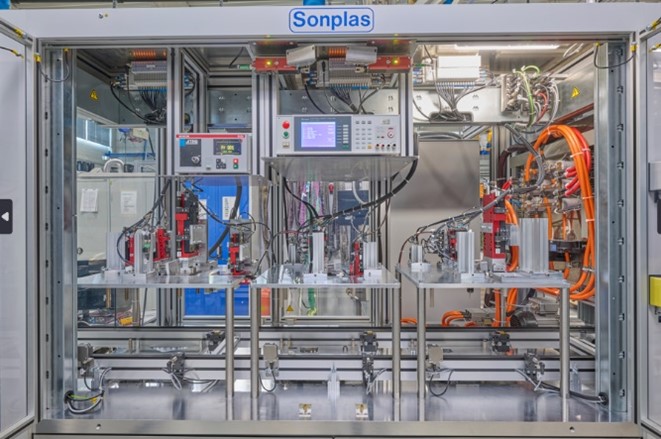Testing power electronics components reliably
Power electronics in electric and hybrid vehicles are improving all the time, and manufacturers wishing to remain competitive need systems that allow them to not only assemble components safely, but also to test them. Sonplas delivers assembly and testing systems, tailored in close collaboration with customers. It delivers everything from a single source, offering innovation and expertise.
The complete propulsion system of an EV is regulated by power electronics. It comprises three components, with the first being the inverter. Its primary function is to convert the DC voltage from the battery into AC voltage for the motor. The second component is the AC charger, often referred to as the charging unit. When refuelling at the socket or wall box, alternating current flows, which this component converts into direct current, thereby charging the battery. Thirdly, there’s the DC/DC converter, responsible for supplying power to the 12 V vehicle electrical system.
“These components are intricate assemblies,” says Alexander Denk, the electrical design team leader at Sonplas in Straubing, Lower Bavaria. “Power electronics is a pivotal technology for the successful evolution of the automotive industry. Innovation cycles are becoming ever shorter. This increases efficiency, while power losses decrease at the same time.”
Companies need to be able to adjust, but this is no easy feat as they often lack the necessary time, and there is a shortage of skilled labour. As a result, they often lack the essential knowledge to successfully drive developments forward.
“We design and implement line concepts for inverters, converters and on-board chargers, ranging from prototype construction to high-performance systems, with cycle times spanning from 20-300 seconds,” says Denk. “Users can utilise it to manufacture typical components ranging from 2-25 kg in weight.”
Depending on project requirements, Sonplas can leverage a wide portfolio of tried and tested, and in some cases patented, processes or it develops customised solutions tailored to the customer’s needs. This allows it to substantially decrease production costs. Denk explains: “With our extensive experience in electronics production, we also develop and manufacture power amplifiers in our own laboratory, for example.”
Sonplas also offers assistance in prototype construction for companies lacking the equipment to produce them in-house.
Precision testing
The manufactured power electronics components must then undergo testing. It is important that this process is adapted to suit the respective requirements precisely. However, this often entails a significant amount of work for manufacturers. Moreover, most suppliers of assembly systems do not provide testing services themselves as they lack the expertise or the necessary equipment.
As a reliable partner, Sonplas has rapidly acquired extensive expertise. “Customers trust our specialists, relying on their experience, comprehensive advice and assessments. This gives them clear added value,” says Denk.
The test systems for the end-of-line (EOL) area have a modular design, which enables the machine manufacturer to customise them according to individual requirements. Depending on the application and specific testing needs, the experts assemble the modules from the modular system accordingly.
The customer receives a basic machine with the suitable test adapter for various product types, thereby saving significant costs. Depending on requirements, the machine can conduct leak testing, typically using air, or flashing to store calibration data, or it can install the operating system. Customers also use the test station to test communications via CAN or Ethernet, for example.
“They can measure and calculate currents, power, and efficiency, and indirectly determine the speed,” says Denk.
Manufacturers also benefit from reliable solutions for safe launch tests, as well as for cold and hot testing of circuit boards or entire assemblies. In order for electric and hybrid vehicles to operate at an optimal level of efficiency, it is essential to maintain the temperature of not only the electric motor and the battery within an optimum range, but also that of the power electronics.
“With our systems, operators can conduct tests ranging from -40 C to 90 C. They are also capable of simulating various environmental conditions,” says Denk.
It is also possible to conduct long-term tests prior to planned series production. The products undergo even more rigorous testing.
“Our systems can accommodate all voltage ranges,” Denk says. This is due to EVs having two electrical systems: the high-voltage system for the drivetrain and the low-voltage system for on-board electronics, including the radio, lights, windscreen wipers and cruise control. For this purpose, a high-voltage battery is installed, which can supply power to the 12 V battery for the onboard electronics via the converter.
“In the past, the voltage became higher and higher,” he adds. “In the beginning, it was only 48 V. Now it is 800 V. The trend is even moving towards 1,200 V.”
This is because more and more power is required for the same amperage, so the systems must be capable of handling both current and future higher-voltage values safely. Numerous tests are conducted directly on the live components of the power electronics. After the test specimens have been tested, it must be ensured that they are no longer energised when the worker opens the safety door. Otherwise, it could pose a life-threatening risk for them.
“We offer a concept that addresses potential causes of accidents and minimises risks,” says Denk. “This begins with the selection of appropriate installation materials, such as cables, terminals, and other components and materials.” Just as safely and effectively as they manage high voltages, the systems also handle peak currents exceeding 800 amperes, resulting in correspondingly high outputs.
Using modular construction, Sonplas can customise the test stations to meet growing demand or accommodate modified products. “Of course, we also provide training to our customers on our systems,” Denk adds.
Dialogue with customers is important to Sonplas. This is how it anticipates trends and strives to stay ahead with innovative solutions.
Click here to read the latest issue of E-Mobility Engineering.
ONLINE PARTNERS






















